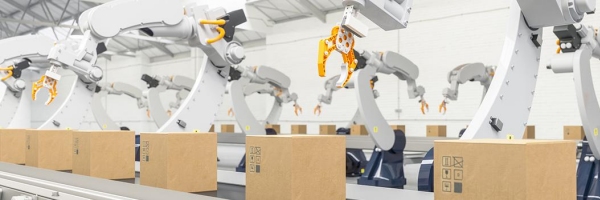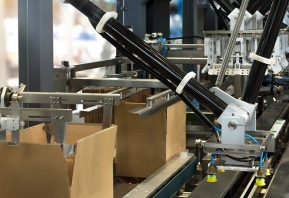
Where Corrugated Packaging Meets Industry 4.0
Oct. 8, 2019 (Paper and Packaging Board) - Corrugated cardboard is an innovation in and of itself. Before its widespread availability, the shipping industry relied mainly on heavy wood crates to transport goods, limiting the speed and frequency of trade. So how well does it play with the next generation of industry — automation? The answer, judging by the automated and roboticized machinery on display at Pack Expo 2019: very well. Not only are makers of corrugated boxboard using automation to continually build upon advantages of the material, but the entire packaging process, from design to transport to the end user, is also benefiting from advances in automation. As with all things packaging, the first thing automators ask is: What do you need to package? “How delicate is it, how does it need to be handled, how many do we need to package and in what kind of box?” says Sebastien Schmitt, North American robotics division manager at Stäubli, a mechatronics company. “That will determine the layout, meaning the size of the machine, and the end-of-arm tooling — the gripping or suction cup. Usually with cardboard, it can be easily handled. It's a more defined environment with that material.” Automation allows products that require more delicacy and care, such as produce, to be handled appropriately, using tools like soft-touch automated grippers that adjust to the needs of the product being packaged. It can also contribute to the longevity of food products by easily adding more stops along the packaging chain to spray boxes with gases meant to prolong shelf life — a step many producers already do, but with less frequency than what automation can support. The result: fresher grapes, fewer bruised peaches and happier consumers. The challenge of labeling corrugated boxes is also becoming less of a sticking point thanks to automation. New adhesive methods like Avery Dennison's technology meant for irregular surfaces come into play. For packagers hoping to go inkless altogether, automated laser printing essentially burns an image directly into an invisible finish applied to the box. “The better and faster you can label a box, the better for tracking, the better for logistics,” says Dan Malenke, president of PKGPRO. “Imagine the possibilities for product recalls — how much easier it will be for producers, retailers and eventually the customer to get the information they need.” But when it comes to imagination, robotics and artificial intelligence are laying a claim. Not that automation is equivalent to robotics: “Sometimes a client may want a robot because that's what they've heard is the way forward, but depending on what they need, robotics might not be the best solution,” says Quentin Burley, product sales manager of robotics at Bosch Packaging Technology. “Robotics is more of an offshoot of automation, and people don't always recognize that at first.”  Where robotics and AI thrive is in delivering on-demand solutions and empowering manufacturers and packagers to continually refine and develop their processes.
Where robotics and AI thrive is in delivering on-demand solutions and empowering manufacturers and packagers to continually refine and develop their processes.
Where robotics and AI thrive is in delivering on-demand solutions and empowering manufacturers and packagers to continually refine and develop their processes. These developments contribute to improved worker safety, speed and accuracy, often with a smaller footprint on the production floor. Siemens' Digital Enterprise portfolio works on a digital twin model, meaning that it can build a virtual replica of companies' machinery and production chain. This allows packagers to virtually test their processes and introduce new scenarios without having to manually reconfigure their machinery — crucial in the landscape of on-demand production, where consumers are asking for more variation in products, at greater speeds than ever before. “This is what the consumer wants,” says Alex Becker, digitalization lead at Siemens. “They want it their way. Working with a digital twin gives you the opportunity to change your process, your product, your production, with a time to market that's reasonable.” Schmitt offers special promotions as an example. “Maybe you're in the candy business, and you want to do a promotion telling customers that they're getting 20 percent more by making a 20 percent bigger box,” Schmitt says. “What automation allows is more flexibility in how and what you package. If you did the same thing with regular machinery, you would require a dedicated machine, so any changes would be difficult to do. It benefits the consumer when you have multiple choices, and it benefits the manufacturer because they have the capability of being flexible and adaptable to their customers' needs. Automation means flexibility.” With 40 percent of equipment manufacturers using a virtual simulation model today, Siemens is part of a growing trend among packagers and related industries to keep pace with Industry 4.0. Corrugated may have been around eons before robots, but the industry can keep pace with technological developments, says Ajay Rana, Siemens business developer of packaging for North America. “The corrugated industry is very big, but with digitalization the risk factor is very little. This allows them to be ahead of the curve.” About the Paper and Packaging BoardThe Paper and Packaging Board promotes the use of paper products and paper-based packaging by highlighting the value they bring to our daily lives. More than 40 U.S. manufacturers and importers collectively fund the national marketing campaign, Paper & Packaging – How Life Unfolds® www.howlifeunfolds.com. To learn more about the Paper and Packaging Board, please visit: paperandpackaging.org. SOURCE: Paper and Packaging Board |